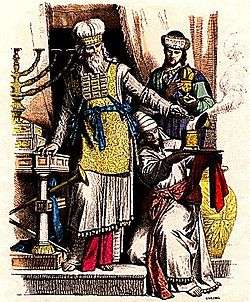Temple robes

Temple robes describe the ceremonial clothing worn in the performance of ordinances and ceremonies in a temple.
Old Testament tradition
The 28th and 29th chapters of the Book of Exodus describe in detail the ritual clothing worn by priests in the ancient temple. The robes consist of a breastplate (hoshen), an ephod, a robe (me'il), a tunic (ketonet), a cap (mitznefet), and a sash (avnet), as well as stones worn in various configurations.
Latter-day Saint tradition
Members of The Church of Jesus Christ of Latter-day Saints (LDS Church) wear ceremonial robes to perform the endowment and sealing portions of their temple ceremonies. The ceremonial robes are modelled after those described in the Bible, according to latter-day revelation. The clothing includes a robe that fits over one shoulder, a sash, an apron, a veil (for women), and a cap (for men). All of the clothing is white, except for the apron, which is green.
Within LDS Church terminology, the term "temple clothing" is sometimes used to describe the non-ceremonial white clothing worn by people throughout the temple, whereas "ceremonial robes" are designated as such. It is common for Latter-day Saints to be buried with the body dressed in their temple robes.
Buddhist tradition
Traditional robes, worn by monks both within and without Buddhist temples, appear in a variety of configurations. In parts of Southeast Asia, the robes consist of a saffron-colored mantel over a red undergarment. In Japan, the robe is traditionally black, grey or blue.
See also
- Vestment liturgical garments
External links
- Exodus 28-29
- Discussion of LDS temple clothing
- Buddhist Ceremonies by Buddhist Monks At The Shaolin Temple